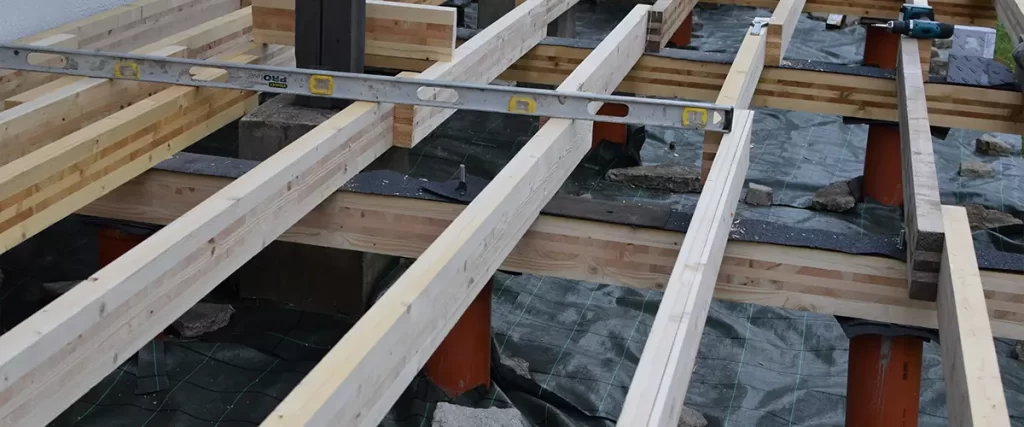There’s nothing quite like a relaxing afternoon on your deck in Southern Pines—until you spot tiny piles of sawdust or holes in the wood that weren’t there before. If you’ve lived in North Carolina for any length of time, you know that termites and carpenter bees aren’t just a nuisance—they’re a real threat to your home.
In fact, our warm, humid climate makes the Sandhills region the perfect breeding ground for these destructive pests. And if you’ve got a wooden deck? You’re their ideal target.
Whether you need a deck builder or trying to keep an old one in great shape, protecting it from insects like termites and carpenter bees is critical. In this guide, we’ll walk you through exactly why these pests love our area, how they can damage your deck, what to look for, and—most importantly—how to stop them in their tracks.

Why North Carolina’s Climate Attracts Termites & Carpenter Bees
Southern Pines, and much of North Carolina, has a humid subtropical climate. This means mild winters and long, hot, humid summers—the exact environment termites and carpenter bees thrive in.
Here’s what makes our area so attractive:
- Moisture: Both termites and carpenter bees are drawn to damp wood. NC’s frequent rains and high humidity create perfect conditions.
- Long warm season: Our mild winters don’t kill off colonies, and the long warm seasons extend their active period.
- Abundant wood structures: Decks, fences, sheds, and wooden siding are all over the place here. If it’s untreated or aged, it’s at risk.
And unfortunately, once these pests find their way into your deck, the damage can be severe—and fast.
The Difference Between Termites and Carpenter Bees (and Why Both Are a Problem)
You’ve probably heard about both pests, but their behavior and the damage they cause are quite different.
Termites: The Silent Destroyers
- Termites eat wood from the inside out.
- You might not see them, but you’ll notice spongy wood, hollow sounds when tapped, or bubbling paint.
- They live in large colonies and can cause massive damage before you even notice they’re there.
Carpenter Bees: The Drillers
- Carpenter bees don’t eat wood—they drill into it to make tunnels for their eggs.
- You’ll see perfectly round holes about the size of a dime, often with sawdust underneath.
- Over time, their nesting can weaken structural wood, especially if multiple generations reuse the same spot.
Both pests can wreak havoc on a wood deck, but the good news is: you can fight back.
Choosing the Right Lumber to Prevent Deck Damage
One of the best ways to protect your deck is starting with the right materials. Not all wood is created equal—especially in our climate.
Use Pressure-Treated Wood
Pressure-treated wood is chemically treated to resist rot, insects, and decay. It’s one of the most popular choices in the South for outdoor structures—and for good reason.
Look for labels that say:
- Ground contact rated – even if it’s not touching the ground, this means it’s highly resistant.
- ACQ or CA preservatives – these are commonly used treatments effective against termites and carpenter bees.
Consider Naturally Resistant Woods
If you’re going for aesthetics or sustainability:
- Cedar
- Redwood
- Cypress
These woods contain natural oils that repel pests, but they’re often more expensive and still need regular maintenance.
How to Inspect Your Deck for Insect Damage
Even the best materials need to be monitored. Get into the habit of inspecting your deck, especially in spring and summer.
Here’s what to check:
- Visible holes or tunnels in the wood
- Sawdust or “frass” beneath beams or on the ground
- Soft or spongy boards that give under pressure
- Buzzing or drilling sounds from carpenter bees
- Swarming termites or discarded wings in early spring
Use a screwdriver to gently press into wood in different spots. If it sinks in easily or feels hollow, that’s a red flag.
How to Protect Your Deck from Termites & Carpenter Bees
1. Seal & Stain Your Deck
Applying a weatherproof sealant or stain not only keeps water out, it helps deter pests. Reseal your deck every 1–2 years.
2. Keep Your Deck Dry
- Fix leaky gutters and ensure proper drainage around your home.
- Trim plants and bushes that hold moisture against your deck.
3. Paint Exposed Ends and Undersides
Termites and bees often attack the most vulnerable parts of your deck. Paint or seal exposed edges and undersides.
4. Install Physical Barriers
Stainless steel mesh or hardware cloth underneath your deck can discourage termites from coming up from the soil.
5. Use Borate-Based Treatments
Borates are a non-toxic (to humans and pets) chemical that prevents insect infestation. Apply during construction or as a maintenance coat.
Top-Rated Manufacturers for Treated Decking Materials
Choosing reliable products is a huge part of preventing insect damage. These manufacturers are trusted nationwide.
- YellaWood – Southern Pine treated lumber with a reputation for durability in humid climates.
- Pressure-Treated Wood by Wolmanized® – Industry-leading pressure-treatment solutions with decades of proven performance.
- Trex (composite alternative) – While not wood, Trex’s composite boards offer a long-lasting, insect-proof decking option.
- Cox Industries – Known for advanced wood treatment technologies used in severe climates.
- Universal Forest Products – Offers a wide range of wood types, all treated for insect resistance.
Why Our Team is the Right Choice for Protecting Your Deck
We’ve been helping homeowners in Southern Pines and surrounding areas protect, repair, and build beautiful, durable decks for years. Our team understands the unique challenges that come with North Carolina’s climate, and we know how to fight back against the pests that come with it.
As with anything in life, you want to work with the best to get the best results. That choice can save you thousands in repairs and replacements in the long run. If you’re ready to get your deck project tackled by true industry pros, give us a call at (910) 985-8064 and let’s get started.

Frequently Asked Questions
How do I know if I have termites or carpenter bees in my deck?
Termites leave behind mud tubes and hollow-sounding wood. Carpenter bees drill round holes and leave sawdust.
Can I treat my deck myself for termites or carpenter bees?
You can apply borate treatments and sealants, but if you already have an infestation, it’s best to get professional help.
How often should I inspect my deck?
At least twice a year—early spring and late summer are ideal times to check for insect activity.
What kind of wood is least likely to be damaged by insects?
Pressure-treated pine, cedar, redwood, and cypress all offer good resistance when properly maintained.
Do carpenter bees sting?
Males don’t sting but may hover aggressively. Females can sting but usually only do so if provoked.
Can termites damage composite decking?
Termites don’t eat composite decking, but they can still damage the underlying wooden frame if it’s untreated.
Is staining my deck really necessary?
Yes! It helps protect against moisture and pests. Think of it as sunscreen for your deck.
What time of year are termites and carpenter bees most active in NC?
They’re most active in spring and early summer, just when you want to be enjoying your deck.
Your Deck Doesn’t Have to Be a Bug Buffet
If you’re living in Southern Pines, deck building protection isn’t optional—it’s essential. The good news is that with the right materials, regular inspections, and a solid maintenance plan, you can keep your deck looking beautiful and bug-free for years.
And when you’re ready to go beyond DIY and bring in the experts, we’re here to help. Contact us today at (910) 985-8064 and let’s protect your outdoor space the right way.
